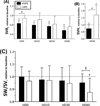Cardiac mechanoenergetic cost of elevated plasma viscosity after moderate hemodilution
- PMID: 21084746
- PMCID: PMC4130999
- DOI: 10.3233/BIR-2010-0574
Cardiac mechanoenergetic cost of elevated plasma viscosity after moderate hemodilution
Abstract
The purpose of this study was to investigate how plasma viscosity affects cardiac and vascular function during moderate hemodilution. Twelve anesthetized hamsters were hemodiluted by 40% of blood volume with two different viscosity plasma expanders. Experimental groups were based on the plasma expander viscosity, namely: high viscosity plasma expander (HVPE, 6.3 mPa · s) and low viscosity plasma expander (LVPE, 2.2 mPa · s). Left ventricular (LV) function was intracardiacally measured with a high temporal resolution miniaturized conductance catheter and concurrent pressure-volume results were used to calculate different LV indices. Independently of the plasma expander, hemodilution decreased hematocrit to 28% in both groups. LVPE hemodilution reduced whole blood viscosity by 40% without changing plasma viscosity, while HVPE hemodilution reduced whole blood viscosity by 23% and almost doubled plasma viscosity relative to baseline. High viscosity plasma expander hemodilution significantly increased cardiac output, stroke volume and stroke work compared to baseline, whereas LVPE hemodilution did not. Furthermore, an increase in plasma viscosity during moderate hemodilution produced a higher energy transfer per unit volume of ejected blood. Systemic vascular resistance decreased after hemodilution in both groups. Counter-intuitively, HVPE hemodilution showed lower vascular resistance and vascular hindrance than LVPE hemodilution. This result suggests that geometrical changes in the circulatory system are induced by the increase in plasma viscosity. In conclusion, an increase in plasma viscosity after moderate hemodilution directly influenced cardiac and vascular function by maintaining hydraulic power and reducing systemic vascular resistance through vasodilation.
Figures






Similar articles
-
Response of cardiac endothelial nitric oxide synthase to plasma viscosity modulation in acute isovolemic hemodilution.Asian J Transfus Sci. 2014 Jul;8(2):100-4. doi: 10.4103/0973-6247.137444. Asian J Transfus Sci. 2014. PMID: 25161348 Free PMC article.
-
Plasma viscosity regulates systemic and microvascular perfusion during acute extreme anemic conditions.Am J Physiol Heart Circ Physiol. 2006 Nov;291(5):H2445-52. doi: 10.1152/ajpheart.00394.2006. Epub 2006 May 26. Am J Physiol Heart Circ Physiol. 2006. PMID: 16731641
-
Effects on cardiac function of a novel low viscosity plasma expander based on polyethylene glycol conjugated albumin.Minerva Anestesiol. 2011 Jul;77(7):704-14. Minerva Anestesiol. 2011. PMID: 21709658
-
Microvascular benefits of increasing plasma viscosity and maintaining blood viscosity: counterintuitive experimental findings.Biorheology. 2009;46(3):167-79. doi: 10.3233/BIR-2009-0539. Biorheology. 2009. PMID: 19581725 Review.
-
Nonlinear cardiovascular regulation consequent to changes in blood viscosity.Clin Hemorheol Microcirc. 2011;49(1-4):29-36. doi: 10.3233/CH-2011-1454. Clin Hemorheol Microcirc. 2011. PMID: 22214675 Review.
Cited by
-
Nitric oxide synthase inhibition attenuates cardiac response to hemodilution with viscogenic plasma expander.Korean Circ J. 2014 Mar;44(2):105-12. doi: 10.4070/kcj.2014.44.2.105. Epub 2014 Mar 12. Korean Circ J. 2014. PMID: 24653740 Free PMC article.
-
Response of cardiac endothelial nitric oxide synthase to plasma viscosity modulation in acute isovolemic hemodilution.Asian J Transfus Sci. 2014 Jul;8(2):100-4. doi: 10.4103/0973-6247.137444. Asian J Transfus Sci. 2014. PMID: 25161348 Free PMC article.
-
Cardiac function during resuscitation from hemorrhagic shock with polymerized bovine hemoglobin-based oxygen therapeutic.Artif Cells Nanomed Biotechnol. 2017 Jun;45(4):686-693. doi: 10.1080/21691401.2016.1241797. Epub 2016 Nov 24. Artif Cells Nanomed Biotechnol. 2017. PMID: 27881020 Free PMC article.
-
Autoregulation and mechanotransduction control the arteriolar response to small changes in hematocrit.Am J Physiol Heart Circ Physiol. 2012 Nov 1;303(9):H1096-106. doi: 10.1152/ajpheart.00438.2012. Epub 2012 Aug 24. Am J Physiol Heart Circ Physiol. 2012. PMID: 22923620 Free PMC article.
-
Exogenous intravascular nitric oxide enhances ventricular function after hemodilution with plasma expander.Life Sci. 2012 Jan 2;90(1-2):39-46. doi: 10.1016/j.lfs.2011.10.013. Epub 2011 Oct 26. Life Sci. 2012. PMID: 22056371 Free PMC article.
References
-
- Alyono D, Ring WS, Chao RY, Alyono MM, Crumbley AJ, Larson EV, Anderson RW. Characteristics of ventricular function in severe hemorrhagic shock. Surgery. 1983;94:250–258. - PubMed
-
- Baan J, van der Velde ET, de Bruin HG, Smeenk GJ, Koops J, van Dijk AD, Temmerman D, Senden J, Buis B. Continuous measurement of left ventricular volume in animals and humans by conductance catheter. Circulation. 1984;70:812–823. - PubMed
-
- Cabrales P, Martini J, Intaglietta M, Tsai AG. Blood viscosity maintains microvascular conditions during normovolemic anemia independent of blood oxygen-carrying capacity. Am J Physiol Heart Circ Physiol. 2006;291:H581–H590. - PubMed
-
- Cabrales P, Tsai AG, Intaglietta M. Alginate plasma expander maintains perfusion and plasma viscosity during extreme hemodilution. Am J Physiol Heart Circ Physiol. 2005;288:H1708–H1716. - PubMed
Publication types
MeSH terms
Grants and funding
LinkOut - more resources
Full Text Sources
Other Literature Sources

